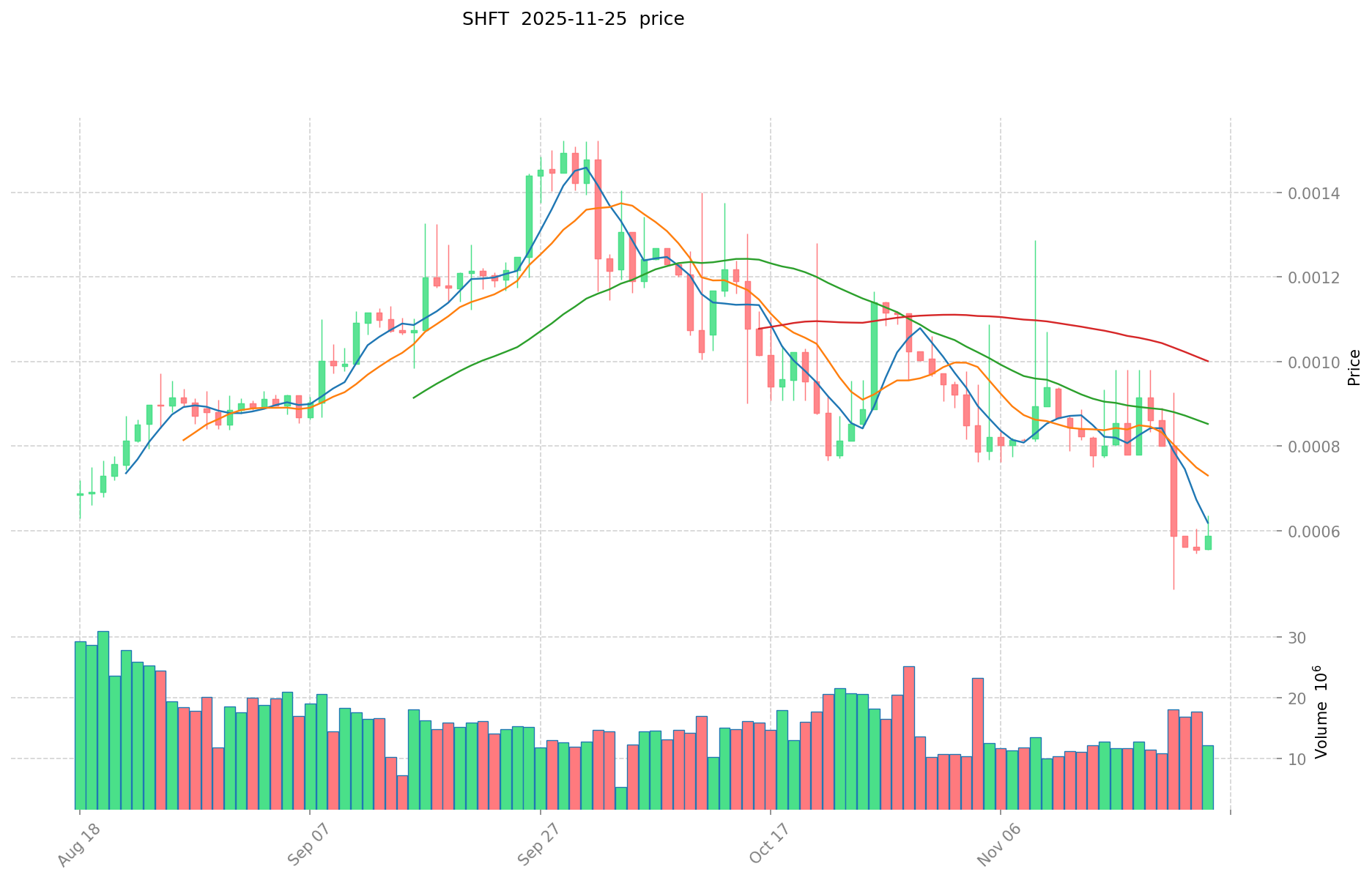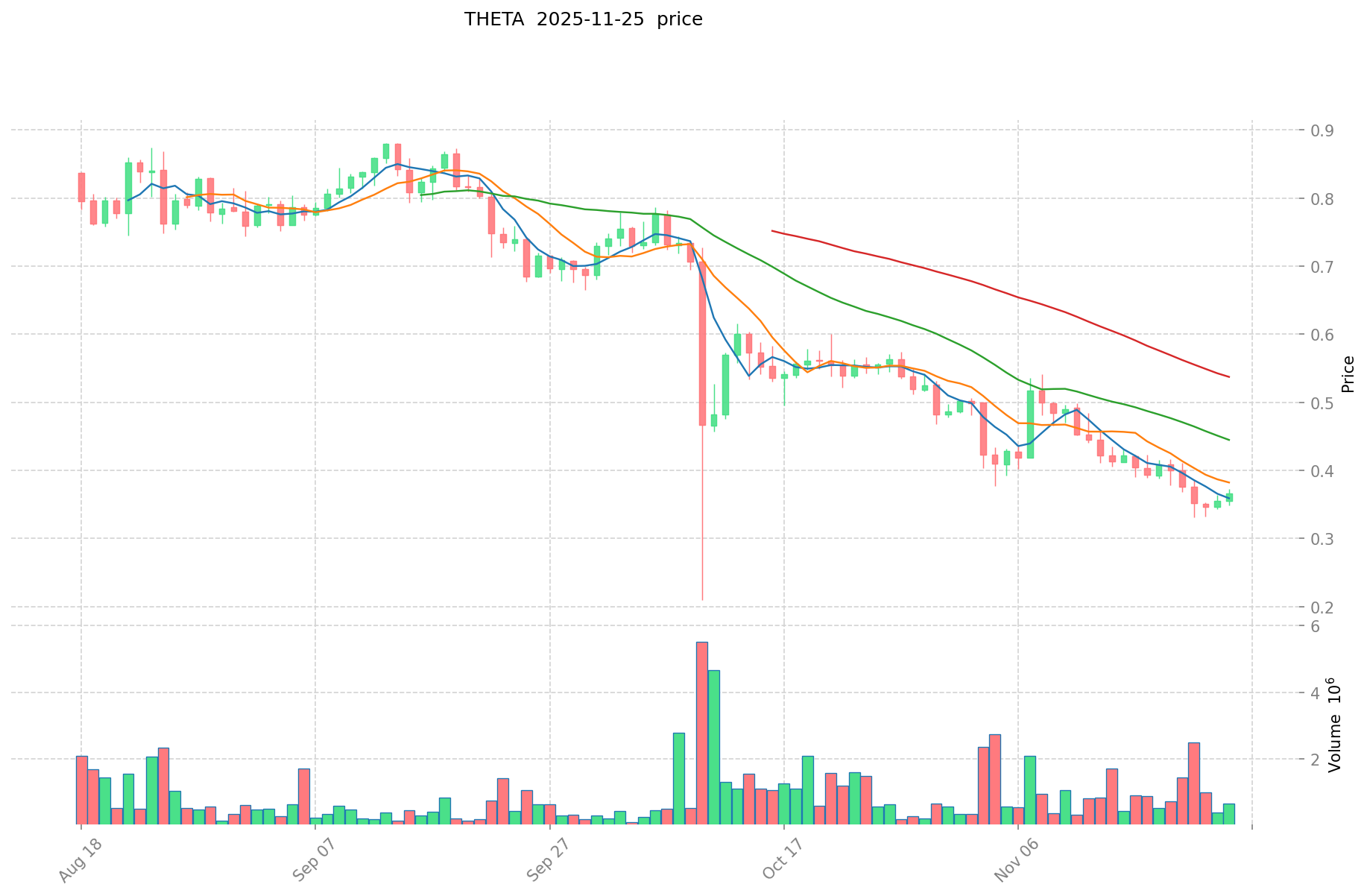SHFT vs THETA: A Comparative Analysis of Two Emerging Blockchain Protocols
Introduction: SHFT vs THETA Investment Comparison
In the cryptocurrency market, the comparison between SHFT and THETA has always been a topic that investors cannot ignore. The two not only have significant differences in market cap ranking, application scenarios, and price performance, but also represent different positioning in crypto assets.
Shyft Network (SHFT): Since its launch in 2021, it has gained market recognition for its focus on trust and authentication in data ecosystems.
THETA (THETA): Introduced in 2017, it has been hailed as a decentralized video streaming platform, and is one of the top cryptocurrencies in terms of global trading volume and market capitalization.
This article will comprehensively analyze the investment value comparison between SHFT and THETA, focusing on historical price trends, supply mechanisms, institutional adoption, technological ecosystems, and future predictions, and attempt to answer the question that investors care about most:
"Which is the better buy right now?"
I. Price History Comparison and Current Market Status
SHFT (Coin A) and THETA (Coin B) Historical Price Trends
- 2021: THETA reached its all-time high of $15.72 due to increased adoption of its video streaming technology.
- 2025: SHFT experienced a significant price decline, reaching its all-time low of $0.0002186.
Current Market Situation (2025-11-25)
- SHFT current price: $0.0005877
- THETA current price: $0.3653
- 24-hour trading volume: $5,394.89 (SHFT) vs $218,055.33 (THETA)
- Market Sentiment Index (Fear & Greed Index): 20 (Extreme Fear)
Click to view real-time prices:
- View SHFT current price Market Price
- View THETA current price Market Price


II. Key Factors Influencing SHFT vs THETA Investment Value
Time Value Decay (Theta Risk)
- THETA: Measures the rate at which option prices decrease as time passes. For at-the-money options, the absolute value of Theta is highest, indicating the fastest time value decay.
- Option sellers profit from Theta, while buyers bear Theta losses.
- Risk factor: When markets remain stable with low volatility, hedging costs continuously consume profits.
Market Volatility Implications
- Higher volatility increases investment value for these assets.
- During stable market periods with low volatility, cost management becomes critical, especially for beginners.
- Options characterized by extremely compressed time value (Theta) feature high leverage and significant risk.
Trading Strategy Considerations
- Dynamic position management: Adjusting investment portfolio allocations based on market conditions, asset price movements, and macroeconomic indicators.
- The core of options trading is preparing for "unpredictability" - strategies should be tested under various market conditions before actual market changes occur.
Risk Management Approach
- For beginners: Controlling costs is essential when markets are stable with limited volatility.
- Investment should be viewed as a collaboration with time rather than a speed competition.
- Stable and patient approaches yield the greatest rewards compared to short-term aggressive stimulation.
III. 2025-2030 Price Prediction: SHFT vs THETA
Short-term Prediction (2025)
- SHFT: Conservative $0.000323235 - $0.0005877 | Optimistic $0.0005877 - $0.000781641
- THETA: Conservative $0.186048 - $0.3648 | Optimistic $0.3648 - $0.397632
Mid-term Prediction (2027)
- SHFT may enter a growth phase, with estimated price range $0.00047879008065 - $0.00084358252305
- THETA may enter a bullish market, with estimated price range $0.4049085744 - $0.5050921392
- Key drivers: Institutional capital inflow, ETF, ecosystem development
Long-term Prediction (2030)
- SHFT: Base scenario $0.000964906219522 - $0.001321921520745 | Optimistic scenario $0.001321921520745
- THETA: Base scenario $0.54341256145176 - $0.793382339719569 | Optimistic scenario $0.793382339719569
Disclaimer
SHFT:
| 年份 | 预测最高价 | 预测平均价格 | 预测最低价 | 涨跌幅 |
|---|---|---|---|---|
| 2025 | 0.000781641 | 0.0005877 | 0.000323235 | 0 |
| 2026 | 0.00083529801 | 0.0006846705 | 0.00035602866 | 16 |
| 2027 | 0.00084358252305 | 0.000759984255 | 0.00047879008065 | 29 |
| 2028 | 0.000906015229598 | 0.000801783389025 | 0.000737640717903 | 36 |
| 2029 | 0.001075913129732 | 0.000853899309311 | 0.000563573544145 | 45 |
| 2030 | 0.001321921520745 | 0.000964906219522 | 0.000771924975617 | 64 |
THETA:
| 年份 | 预测最高价 | 预测平均价格 | 预测最低价 | 涨跌幅 |
|---|---|---|---|---|
| 2025 | 0.397632 | 0.3648 | 0.186048 | 0 |
| 2026 | 0.45364704 | 0.381216 | 0.24016608 | 4 |
| 2027 | 0.5050921392 | 0.41743152 | 0.4049085744 | 14 |
| 2028 | 0.604252996776 | 0.4612618296 | 0.405910410048 | 26 |
| 2029 | 0.55406770971552 | 0.532757413188 | 0.47415409773732 | 45 |
| 2030 | 0.793382339719569 | 0.54341256145176 | 0.412993546703337 | 48 |
IV. Investment Strategy Comparison: SHFT vs THETA
Long-term vs Short-term Investment Strategies
- SHFT: Suitable for investors focused on data trust and authentication ecosystems
- THETA: Suitable for investors interested in decentralized video streaming technology
Risk Management and Asset Allocation
- Conservative investors: SHFT: 20% vs THETA: 80%
- Aggressive investors: SHFT: 40% vs THETA: 60%
- Hedging tools: Stablecoin allocation, options, cross-currency combinations
V. Potential Risk Comparison
Market Risk
- SHFT: Higher volatility due to lower market cap and trading volume
- THETA: Exposure to fluctuations in the video streaming industry
Technical Risk
- SHFT: Scalability, network stability
- THETA: Computing power concentration, security vulnerabilities
Regulatory Risk
- Global regulatory policies may have different impacts on both assets
VI. Conclusion: Which Is the Better Buy?
📌 Investment Value Summary:
- SHFT advantages: Focus on trust and authentication in data ecosystems
- THETA advantages: Established position in decentralized video streaming, higher market cap and liquidity
✅ Investment Advice:
- New investors: Consider THETA for its higher liquidity and established market position
- Experienced investors: Diversify between SHFT and THETA based on risk tolerance
- Institutional investors: Evaluate both assets based on their specific use cases and potential for ecosystem growth
⚠️ Risk Warning: Cryptocurrency markets are highly volatile. This article does not constitute investment advice. None
VII. FAQ
Q1: What are the main differences between SHFT and THETA? A: SHFT focuses on trust and authentication in data ecosystems, while THETA is a decentralized video streaming platform. THETA has a higher market cap, trading volume, and liquidity compared to SHFT.
Q2: Which coin has shown better price performance historically? A: THETA has shown better historical price performance, reaching an all-time high of $15.72 in 2021. SHFT, on the other hand, experienced a significant price decline, reaching its all-time low of $0.0002186 in 2025.
Q3: How do the current market prices compare between SHFT and THETA? A: As of 2025-11-25, SHFT's current price is $0.0005877, while THETA's current price is $0.3653. THETA has a significantly higher 24-hour trading volume of $218,055.33 compared to SHFT's $5,394.89.
Q4: What are the price predictions for SHFT and THETA by 2030? A: For SHFT, the base scenario predicts a range of $0.000964906219522 - $0.001321921520745. For THETA, the base scenario predicts a range of $0.54341256145176 - $0.793382339719569.
Q5: How should investors allocate their assets between SHFT and THETA? A: Conservative investors might consider allocating 20% to SHFT and 80% to THETA, while aggressive investors might opt for 40% SHFT and 60% THETA. The exact allocation should be based on individual risk tolerance and investment goals.
Q6: What are the potential risks associated with investing in SHFT and THETA? A: Both coins face market, technical, and regulatory risks. SHFT has higher volatility due to its lower market cap and trading volume, while THETA is exposed to fluctuations in the video streaming industry. Technical risks include scalability and security issues for both assets.
Q7: Which coin might be more suitable for new investors? A: New investors might consider THETA due to its higher liquidity and established market position. However, all investments should be made based on thorough research and individual risk tolerance.
Share
Content